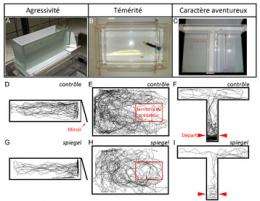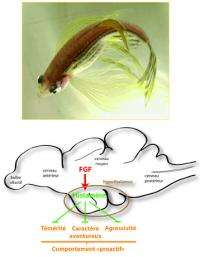Aggression-boldness gene identified in model fish

A gene responsible for aggressive and bold behavior has been identified in zebrafish by a French team from CNRS/Laboratoire Neurobiologie et Développement. This specific behavioral association, whose three characteristics are boldness, exploratory behavior and aggressiveness, has been described in many animal species. In zebrafish, it could be due to the action of a single gene (fgfr-1) through its regulation of histamine levels in the brain, as histamine is the neurotransmitter involved in numerous behavioral traits. These results are published in The Journal of Neuroscience on 28 September 2011.
The “Aggression-boldness syndrome” is well known to specialists. It is characterized by above-average boldness, exploratory behavior and aggressiveness. This syndrome, also known as proactive behavior, has been described in numerous species of fish, birds and mammals. Researchers from CNRS/Laboratoire Neurobiologie et Développement decided to study it in zebrafish, an animal model increasingly used by both geneticists and neurobiologists. They firstly developed behavioral tests so as to quantitatively measure the three facets of this aggressive and bold behavior. They then identified a strain of zebrafish, known as spiegeldanio, whose proactive nature clearly differs from the norm. Tests have shown that these fish are particularly aggressive towards their congeners, little intimidated by lures simulating predators and more adventurous in exploring new environments.

The spiegeldanio strain has a mutation in its fgfr-1 gene coding for a membrane receptor sensitive to FGF, a growth factor that plays a key role in the development of vertebrates, particularly in brain growth. The mutation of the Fgfr1 receptor present in spiegeldanio reduces the activation of the intracellular signals normally triggered by FGF. As a consequence of this mutation, spiegeldanio fish exhibit low brain levels of histamine, a neurotransmitter known to regulate appetite, sleep and attention. These low histamine levels are responsible for the abnormal behavior of the zebrafish. In fact, a simple pharmacological treatment aimed at increasing histamine levels made fish with the spiegeldanio mutation recover normal behavior, in other words average zebrafish behavior.
This work shows that the combination of the three characteristics defining aggressive and bold behavior depends on the action of a single gene present in all vertebrates. Environmental factors (physico-chemistry, animal density, food supply, etc.) are also likely to have an influence on behavior, but the fgfr-1 gene seems to regulate the basic level of proactivity. These results shed light on this specific molecular and neurophysiological behavior. Nevertheless, further studies must be carried out to elucidate the molecular mechanisms that link the fgfr-1 gene to histamine levels and the production of histamine to animal behavior.
More information: Modulation of Fgfr1a Signaling in Zebrafish Reveals a Genetic Basis for the Aggression–Boldness Syndrome. William H. J. Norton, et al. The Journal of Neuroscience, 28 September 2011.
















